"I think it's for collecting rain water."
"No, I think it's a device for controlling the weather."
"Well, whatever it is, it's the strangest contraption I've ever seen in a Wheaton backyard."
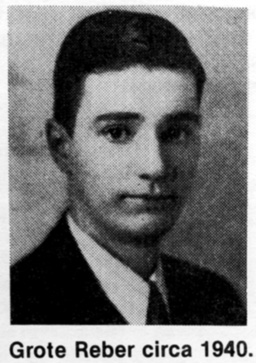
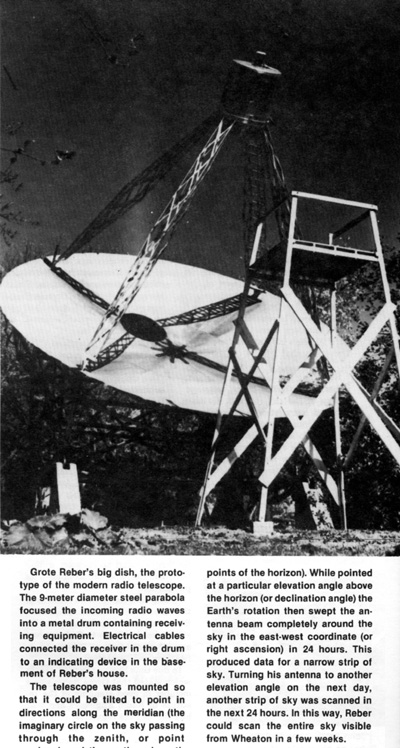 The residents were puzzled but the neighborhood children were delighted, for there in Grote Reber's backyard was something more fun to climb than any jungle-gym they'd seen before. Towering three stories high was a huge steel saucer supported from below by a network of wooden timbers and trusses. Designed and built by Grote Reber during the summer of 1937, it was the forerunner and prototype of the modern radio telescope. With it Reber soon began to follow up on Karl Jansky's discovery of radio waves from our galaxy and for a decade Reber was the world's only active radio astronomer, keeping a lonely vigil of
the heavens and producing the first maps of the radio sky.
The residents were puzzled but the neighborhood children were delighted, for there in Grote Reber's backyard was something more fun to climb than any jungle-gym they'd seen before. Towering three stories high was a huge steel saucer supported from below by a network of wooden timbers and trusses. Designed and built by Grote Reber during the summer of 1937, it was the forerunner and prototype of the modern radio telescope. With it Reber soon began to follow up on Karl Jansky's discovery of radio waves from our galaxy and for a decade Reber was the world's only active radio astronomer, keeping a lonely vigil of
the heavens and producing the first maps of the radio sky.
Karl Jansky's discovery of radio waves from our galaxy* (* Part 1. COSMIC SEARCH, Fall 1981, Serial no. 12, page 8.) was an historic event. With his merry-go-round antenna he opened a new window on the cosmos, a discovery that ranks with the works of Copernicus and Galileo.
Jansky was well aware of his discovery's importance. He wanted to follow up with further studies of his "star static" over a range of wavelengths; he wanted to build a 30-meter diameter steerable parabolic dish antenna to map the source of the radiation in more detail. But he obtained no support for his proposals. He even considered going to Iowa State University, where he hoped, in a university atmosphere, he might be able to pursue his interest but nothing came of it. And, no one else followed up immediately on his discovery so his momentous break-through, born in a fallow potato field, lay fallow on the world for several years.
But by 1938 Grote Reber had begun his observations in Wheaton, Illinois. A graduate of the Illinois Institute of Technology in 1933, Reber was a radio engineer and avid radio amateur. From his amateur station, W9GFZ, he had communicated with other amateurs in more than 60 countries on all continents and he looked for more distant conquests. Would it be possible, he wondered, to beam a pulse of radio waves to the Moon and receive an echo? He made elaborate plans and actually a few unsuccessful attempts until additional calculations convinced him that he would require more transmitter power than the one
kilowatt to which U.S. amateurs are restricted. In his Moon bounce experiment Reber anticipated by a dozen years Jack DeWitt's successful experiment with much more powerful equipment.* (* See COSMIC SEARCH, No. 7, page 27; also "Our Cosmic Universe" by John Kraus, Cygnus-Quasar Books, 1980, page 152.) But Reber had read Jansky's articles in the "Proceedings" of the Institute of Radio Engineers, the radio waves Jansky had discovered spanning the vast distances from the depths of our galaxy whetting his interest.
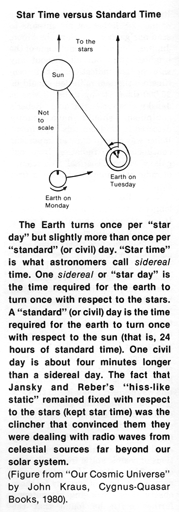 The big 9-meter diameter steel dish in his backyard was Reber's antenna for collecting Jansky's "star-static" or what Reber preferred to call "cosmic static". The radio energy from the antenna was focussed into a receiver which in turn operated a meter that indicated the strength of the hiss static. Collectively, the antenna, receiver and indicator constitute a "radio telescope".
The big 9-meter diameter steel dish in his backyard was Reber's antenna for collecting Jansky's "star-static" or what Reber preferred to call "cosmic static". The radio energy from the antenna was focussed into a receiver which in turn operated a meter that indicated the strength of the hiss static. Collectively, the antenna, receiver and indicator constitute a "radio telescope".
At the time of Jansky's discovery, the most likely explanation of the celestial radio radiation was that it was of a thermal origin, from hot objects, and should be stronger at shorter wavelengths. So on this assumption Grote Reber designed and built his first receiver to operate at 9 centimeters, the shortest wavelength it was practical to use at that time.
To build a receiver for this short wavelength required a great deal of experimental work by Reber involving tests on the many components he planned to use. By the spring of 1938 his entire system, antenna, receiver and indicator, was operational and Reber began systematic observations of the sky. Reber set his antenna to scan our galaxy, the Sun, the Moon, Jupiter, Venus, Mars and some of the brighter stars but all without any sign of an indication. At 9 centimeters thermal radiation should be 25,000 times stronger than it was at Jansky's wavelength and Reber's equipment should have readily detected it. So from this experiment Reber was able to draw an important conclusion: the radiation from our galaxy was not thermal. The science of radio astronomy had taken a first step.
Next, Reber decided to try the longer wavelength of 33 centimeters. It was not merely a matter of retuning the 9 centimeter receiver. An almost entirely new receiver had to be designed and built. He had this unit working by the autumn of 1938 but observations of all the previously examined objects in the sky again brought negative results. Reber began to wonder if the galactic radiation might behave just the opposite to thermal radiation and become stronger at longer wavelengths?
So once again he set about constructing another receiver for the still longer wavelength of 1.9 meters. At this wavelength Reber found that the ignition systems of passing automobiles produced a severe interfering static or popping noise but late at night this trouble was absent and by April 1939 he obtained strong indications of cosmic static from the center of the Milky Way! His antenna was pointing to the southern sky for these observations. Swinging his antenna further north he found that the cosmic static became weaker, thus confirming Jansky's findings in a general way.
All this while Grote Reber worked by day designing radio receivers at a nearby factory. After supper he slept until midnight, and then until he left for work the next morning, he sat in his basement beside the receiver and recorded the output meter readings at one minute intervals. On weekends he had the opportunity to record data at other times but during the daytime the automobile ignition interference prevented him from making good observations. During the summer of 1939 Reber pointed his antenna at many other celestial objects but found nothing besides the Milky Way radiation.
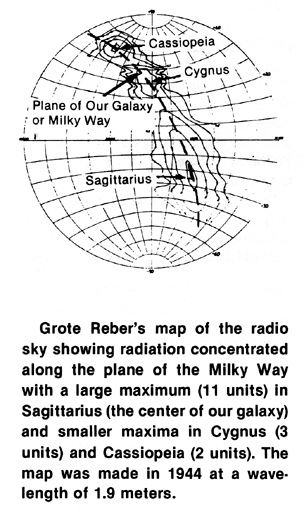 Encouraged by his detection of the galactic radiation, Reber next made several improvements in his receiver and purchased an automatic recorder giving a pen trace on a moving paper chart. No longer would he have to sit up all night recording data. With these changes Reber then embarked on the first systematic survey of the radio sky in 1941.
Encouraged by his detection of the galactic radiation, Reber next made several improvements in his receiver and purchased an automatic recorder giving a pen trace on a moving paper chart. No longer would he have to sit up all night recording data. With these changes Reber then embarked on the first systematic survey of the radio sky in 1941.
Then, for a while Reber left Wheaton to do research on protection devices for ships at the Naval Ordnance Laboratory in Washington, D.C. I was also doing similar research at the Naval Ordnance Laboratory. Reber and I stayed at the same rooming house where he told me about his equipment and observations of the Milky Way with a contagious enthusiasm. If we had not been at war I think I would have started building a radio telescope then. But it was not until 10 years later at the Ohio State University that I had a chance to do it.
Returning to his job in Illinois, Reber undertook a more complete survey of the sky in 1943. He also detected very strong radio waves from the sun.
The radio maps Reber made showed clearly the concentration of radiation along the plane of the Milky Way. The strongest radiation came from the center of our galaxy, in Sagittarius, with other less strong maxima or "hot spots" in Cygnus and Cassiopeia. The sources of the Cygnus and Cassiopeia radiation were later found to be extremely distant objects, the one in Cygnus an exploded galaxy at a distance of one billion light-years.
Although Jansky's merry-go-round antenna was physically larger than Reber's, the Wheaton antenna operated at a much shorter wavelength giving Reber better resolution or ability to separate and pin-point objects in the sky. Thus, the beam width or resolution angle of Jansky's antenna was about 30° whereas Reber's was about 12°. Later when Reber went successfully to a wavelength of 62 centimeters, he sharpened his antenna's resolution angle to about 4°.
Grote Reber published many articles about his results, most of them in the "Proceedings" of the Institute of Radio Engineers but also some in other professional journals. One of his articles entitled "Cosmic Static" was published in the June 1940 issue of the "Astrophysical Journal" and thereon hangs a tale.
When Reber submitted this article to the "Astrophysical Journal" it was the first time an article reporting radio emission from the sky had been submitted to an astronomical publication. The "Astrophysical Journal" was, and is, a refereed journal, that is, manuscripts submitted to it are sent to anonymous third party experts for their appraisal. Accordingly, Dr. Otto Struve, the journal editor sent Reber's manuscript to a number of referees. Astronomer referees returned Reber's manuscript with the comment that they didn't understand the radio terminology. Radio engineer referees returned the manuscript stating that they didn't grasp the astronomical implications. So Struve found no reviewer willing to defend the paper or recommend its publication.
Noting that Reber was a member of the Institute of Radio Engineers, Struve wrote in desperation to the Institute headquarters to find if it had any information about Reber's qualifications and reputation.
In due time Struve received a reply which stated that Grote Reber was a member in good standing of the Institute of Radio Engineers and that he paid his dues regularly!
At this point Dr. Struve was in a quandry. He had ample grounds for rejecting Reber's contribution; but reasoning that a good article rejected would be a greater evil than a poor paper accepted, he approved Reber's article for publication.
In 1940, when the article finally appeared, World War II was in progress, and Holland had fallen under Nazi occupation. But eventually a copy of the "Astrophysical Journal" carrying Reber's article reached the observatory at Leiden.
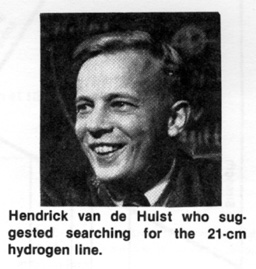 The article came to the attention of Hendrick van de Hulst, a young astronomer at the Leiden Observatory, who recognized that the radiation Reber and Jansky had observed must extend continuously over a wide range of wavelengths. In addition to this ubiquitous radiation that is like the hissing one hears all across the dial of a radio receiver when no stations are on the air, van de Hulst wondered if there might also be some radiation at a single wavelength, like from a radio station that comes in at a single point on the dial. So he investigated whether any theories might predict that some of the matter in space would have a single wavelength or "line radiation". In 1944, van de Hulst reported at a Leiden Observatory colloquium that hydrogen, the most abundant element in space, was a likely candidate. It had a natural wavelength of 21 centimeters corresponding to two different conditions of the atom's single electron. When the condition changed, the atom would emit a brief pulse or "beep" of 21 centimeter radiation, or under other circumstances it would absorb or act as a receiver for this same wavelength. Although the emission of a beep from a particular hydrogen atom might occur only once in million years, van de Hulst thought that there might be enough hydrogen in some regions of space that the combined beeps of the vast numbers of hydrogen atoms could be detected, and he suggested that a search be made.
The article came to the attention of Hendrick van de Hulst, a young astronomer at the Leiden Observatory, who recognized that the radiation Reber and Jansky had observed must extend continuously over a wide range of wavelengths. In addition to this ubiquitous radiation that is like the hissing one hears all across the dial of a radio receiver when no stations are on the air, van de Hulst wondered if there might also be some radiation at a single wavelength, like from a radio station that comes in at a single point on the dial. So he investigated whether any theories might predict that some of the matter in space would have a single wavelength or "line radiation". In 1944, van de Hulst reported at a Leiden Observatory colloquium that hydrogen, the most abundant element in space, was a likely candidate. It had a natural wavelength of 21 centimeters corresponding to two different conditions of the atom's single electron. When the condition changed, the atom would emit a brief pulse or "beep" of 21 centimeter radiation, or under other circumstances it would absorb or act as a receiver for this same wavelength. Although the emission of a beep from a particular hydrogen atom might occur only once in million years, van de Hulst thought that there might be enough hydrogen in some regions of space that the combined beeps of the vast numbers of hydrogen atoms could be detected, and he suggested that a search be made.
Seven years later, Harold Ewen and Edward Purcell of Harvard University detected the 21 centimeter hydrogen line radiation coming, as did Jansky's all-wavelength radiation, from the center of our galaxy. Within weeks it was also detected by other radio observatories in Holland and in Australia.
Observations of the hydrogen line have been of immense value, and research at this wavelength has become one of the most important and active phases of radio astronomy. One of the most spectacular results has been the mapping of the structure of our galaxy. These developments will be discussed in a later installment.
In retrospect, Reber's article, which might not have been published at all, turned out to be one of the classic articles of radio astronomy and also an important catalyst in the formation of a new field of research dealing with the 21 centimeter hydrogen line.

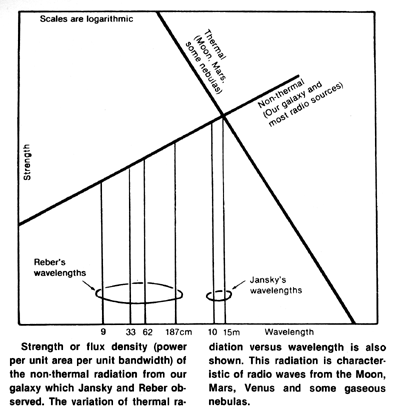
 Reber fills an important niche in the history of science. He was the first to follow up on Jansky's work and extend it, laying the foundations of the new science of radio astronomy, and for a decade he alone nurtured and developed it. Reber's telescope is the prototype of the modern radio telescope. By observing the cosmic static at new wavelengths Reber demonstrated that it extended over a wide spectrum. By failing to detect it at sufficiently short wavelengths he was able to conclude that the cosmic static was not of thermal origin. It was later explained as coming from electrons in nearly empty space moving at high velocity in magnetic fields. Reber drew the first maps of the radio sky showing the strongest radiation coming from the center of our galaxy, confirming Jansky's result. Reber's maps also showed other regions of strong radiation in Cygnus and Cassiopeia. His numerous articles began to draw the attention of astronomers and one of his articles was the stimulus that resulted in the prediction and detection of the 21 centimeter hydrogen line.
Reber fills an important niche in the history of science. He was the first to follow up on Jansky's work and extend it, laying the foundations of the new science of radio astronomy, and for a decade he alone nurtured and developed it. Reber's telescope is the prototype of the modern radio telescope. By observing the cosmic static at new wavelengths Reber demonstrated that it extended over a wide spectrum. By failing to detect it at sufficiently short wavelengths he was able to conclude that the cosmic static was not of thermal origin. It was later explained as coming from electrons in nearly empty space moving at high velocity in magnetic fields. Reber drew the first maps of the radio sky showing the strongest radiation coming from the center of our galaxy, confirming Jansky's result. Reber's maps also showed other regions of strong radiation in Cygnus and Cassiopeia. His numerous articles began to draw the attention of astronomers and one of his articles was the stimulus that resulted in the prediction and detection of the 21 centimeter hydrogen line.
Reber is unique among scientists in that he plans his experiments with meticulous care, designs and builds most or all of his apparatus himself, makes his own observations, plots and interprets his data himself and compares his results, where possible, with theory. In a word, Reber conducts all aspects of his research; he was, and still is, a one man largely self-supported scientific laboratory. In recognition of his genius the Ohio State University conferred an honorary Doctor of Science degree on Reber in 1962. In the same year he received the Bruce gold medal of the Astronomical Society of the Pacific and the following year he was the recipient of the Elliot Cresson gold medal of the Franklin Institute.
Reber has continued over the years to pioneer in special areas of radio astronomy as will be related in later parts of this series.

Partial list of Grote Reber's publications prior to 1946
"Electromagnetic Horns", Communications, Feb. 1939, p. 13.
"Cosmic Static", Proceedings Institute of Radio Engineers, Feb. 1940, p. 68.
"Cosmic Static", Astrophysical Journal, June 1940, p. 621.
"Cosmic Static", Proceedings Institute of Radio Engineers, Aug. 1942, p. 376.
"Cosmic Static", Astrophysical Journal, Nov. 1944, p. 279.
"Reflector Efficiency", Electronics Industry, July 1944, p. 101.
"Solar Radiation at 480 Mc/sec", Nature, Dec. 28, 1946, p. 945.
|
Historical Sidelights
Edwin Hubble in Pasadena, California, was just reaching his dramatic conclusions that we lived in an expanding universe when Karl Jansky at Holmdel, New Jersey, was puzzling over charts recorded with his merry-go-round antenna. Soon thereafter Grote Reber began measuring what he called "cosmic static" with his backyard parabolic dish in the Chicago suburb of Wheaton.
Edwin Hubble and Grote Reber — could there be more than a cosmic connection between them, both being astronomers, one optical and the other radio? Yes, it turns out, there is.
Around 1900 the Hubble family lived in Wheaton, Illinois, and as his 7th and 8th grade teacher young Edwin Hubble had a Miss Harriet Grote who later married Schuyler Reber and bore him Grote Reber as their first son. She often commented to Grote that young Edwin Hubble stood out from other students in his class and that she felt he would go far. In later years, when Hubble's fame was spreading she took special pride in his accomplishments and that she had been his teacher.
Reprinted from "Big Ear" by John Kraus, Cygnus-Quasar Books, 1980.
•
About 1930, Gordon Stagner, a young radio operator at the Manila, Philippines, RCA station noticed that, in the absence of thunderstorm static, the hiss noise he heard on some short-wave antennas was much higher than on others. He was puzzled and wanted to investigate the matter but was told to stop wasting his time worrying about it and nothing more came of it. But when Karl Jansky's articles appeared in the "Proceedings" of the Institute of Radio Engineers a year or so later, Stagner realized what was going on; the strong hiss noise had occurred on those antennas directed toward the center of our galaxy.
•
In the 1930s; the idea of radio waves from celestial objects was foreign to the thinking of most astronomers. Radio waves were a million times longer than the light waves of the visible spectrum and the observational techniques were radically different. Even so, a number of astronomers recognized the significance of Jansky's discovery although they were not in a position to do much about it.
It was reported by Karl Jansky's father that at a University of Wisconsin astronomy colloquium he attended in 1933, Joel Stebbins commented that physicists might not be interested in Karl Jansky's discovery but astronomers certainly should be since the point in the sky where the signal was coming from was the point which astronomers believed to be the center of our galaxy. Stebbins, famous for his work measuring star light with photocells, was Professor of Astronomy and for many years Director of the university's Washburn Observatory.
According to George C. Southworth, famous for his waveguide research at Bell Laboratories, it was not until after Grote Reber "literally drew them a picture" of the radio sky that astronomers generally began to appreciate what Jansky had started.
|
![[NAAPO Logo]](../../Images/NAAPOsm.jpg)
![[NAAPO Logo]](../../Images/NAAPOsm.jpg)